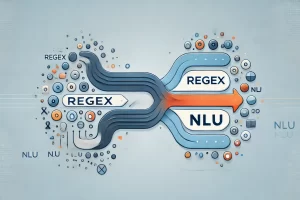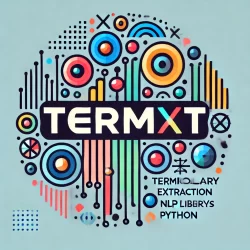NLP – Natural Language Processing
This is a non-exhaustive glossary generated by ChatGPT in a chat conversation human-AI.
CChunking
The process of dividing a piece of text into non-overlapping chunks or phrases. Chunking is used to group words into phrases that have a common syntactic or semantic role in the sentence, such as noun phrases and verb phrases.
DDeep learning
A subfield of machine learning that uses neural networks with many layers to learn complex patterns in data. Deep learning has been applied to many NLP tasks, such as language modeling, machine translation, and text summarization, and has achieved state-of-the-art performance in many of these tasks.
Deep learning for NLP
The use of deep neural networks to perform various NLP tasks, such as text classification and machine translation. Deep learning algorithms can learn complex patterns in natural language data and can achieve state-of-the-art performance on many NLP tasks.
Dialogue systems
Also known as chatbots, dialogue systems are computer programs that can hold natural language conversations with humans. Dialogue systems use various NLP techniques, such as natural language understanding and natural language generation, to interpret and respond to user inputs in a conversational manner.
Discourse analysis
The process of analyzing the structure and organization of a piece of text beyond the level of individual sentences. Discourse analysis focuses on how the sentences in a text relate to each other and form a coherent whole, and it can be used to analyze the structure and coherence of a text and identify the main ideas and arguments it conveys.
Discourse context
The information that is needed to interpret the meaning of a sentence or piece of text in a larger discourse. Discourse context can include information about the topic of the discourse, the entities and events mentioned in previous sentences, and the overall goals and intentions of the speaker or writer. Discourse context is important in NLP because it can affect the interpretation of a sentence and the decisions made by NLP algorithms.
EEthics in natural language processing
The study of the ethical implications of NLP techniques and applications. Ethical issues in NLP include bias in algorithms, privacy concerns, and the potential impact of NLP on society and the economy.
Evaluation of NLP systems
The development of metrics and techniques for evaluating the performance of NLP algorithms on specific tasks or datasets. NLP evaluation is important for comparing different algorithms and for determining the real-world effectiveness of NLP systems.
HHuman-computer interaction
The study of the ways in which humans and computers communicate and interact with each other. Human-computer interaction research includes the design and evaluation of user interfaces and other systems that use natural language as the primary mode of communication.
IInformation extraction
The process of automatically extracting structured information from unstructured or semi-structured text. Information extraction algorithms use various NLP techniques, such as named entity recognition and relation extraction, to identify and extract specific pieces of information from a text.
Information retrieval
The process of searching for and retrieving documents or other pieces of information that are relevant to a given query. Information retrieval algorithms use various NLP techniques, such as text similarity measures and text classification, to rank and retrieve the most relevant documents.
LLanguage model
A statistical model that assigns probabilities to sequences of words. Language models are used in many NLP tasks, such as speech recognition and machine translation, to predict the likelihood of a given sequence of words and select the most likely sequence as the output.
Language modeling
The process of predicting the next word or phrase in a sequence of text. Language models are trained on large corpora of text and can be used to generate text that is similar to human language, to improve the performance of other NLP tasks, or to evaluate the fluency and coherence of a given piece of text.
Lemmatization
The process of reducing a word to its lemma, which is the base form of the word. Lemmatization is similar to stemming, but it is more linguistically accurate and preserves the meaning of the word.
Lexical analysis
The process of analyzing a piece of text to identify the individual words and phrases that make up the text. Lexical analysis is the first step in many NLP tasks, and it involves tasks such as tokenization, stemming, and lemmatization.
MMachine translation
The process of automatically translating text from one natural language to another. Machine translation algorithms use statistical and rule-based methods to map the words and phrases in the source language to their equivalents in the target language.
Machine translation
The process of automatically translating text from one language to another. Machine translation systems use NLP techniques, such as natural language understanding and natural language generation, to analyze the source text and generate a translation in the target language.
Multilingual NLP
The development of NLP techniques that can handle multiple languages and language pairs. Multilingual NLP algorithms can learn from large amounts of data in multiple languages and can perform tasks such as machine translation and cross-lingual text classification.
NNamed entity recognition
The process of identifying named entities (people, organizations, locations, etc.) in a piece of text and classifying them into pre-defined categories.
Natural language generation
The process of generating text that is similar to human language. Natural language generation algorithms can be trained on large corpora of human-generated text and can produce text that is fluent, coherent, and relevant to a given topic.
Natural language generation
The process of generating text that is similar to human language. Natural language generation algorithms can be trained on large corpora of human-generated text and can produce text that is fluent, coherent, and relevant to a given topic.
Natural language generation
The process of generating text that is similar to human language. Natural language generation algorithms can be trained on large corpora of human-generated text and can produce text that is fluent, coherent, and relevant to a given topic.
Natural language interfaces
The design and implementation of systems that enable humans to interact with computers using natural language. Natural language interfaces can be used to control devices, access information, and perform other tasks using spoken or written language.
Natural Language Processing (NLP)
A field of artificial intelligence and computational linguistics that focuses on the interaction between computers and human (natural) languages. NLP techniques are used to analyze and generate text, speech, and other forms of natural language data.
Natural language processing for the Web
The application of NLP techniques to the World Wide Web. NLP for the Web involves tasks such as web scraping, information extraction from web pages, and the analysis of social media text and other online user-generated content.
Natural language understanding
The process of extracting meaning from natural language input. Natural language understanding algorithms use various NLP techniques, such as syntactic parsing and semantic analysis, to interpret the meaning of sentences and identify the entities, events, and relationships mentioned in the text.
PParsing
The process of analyzing the syntactic structure of a sentence or piece of text and constructing a parse tree that represents the grammatical relationships among the words in the sentence. Parsing is an essential step in many NLP tasks, such as text summarization, machine translation, and information extraction.
Part-of-speech tagging
The process of assigning a part-of-speech label (noun, verb, adjective, etc.) to each word in a sentence. Part-of-speech tagging is an essential step in many NLP tasks, such as syntactic parsing and text summarization.
Part-of-speech tagging
The process of assigning a part-of-speech label (noun, verb, adjective, etc.) to each word in a sentence. Part-of-speech tagging is used to identify the syntactic role of each word in a sentence and improve the performance of many NLP algorithms.
Pragmatics
The study of the factors that determine the meaning of a sentence beyond its literal meaning. Pragmatics takes into account the context in which a sentence is used and the intended meaning of the speaker, and it is used in NLP to improve the interpretation of natural language sentences.
QQuestion answering
The process of automatically answering questions posed in natural language. Question answering systems use NLP techniques, such as natural language understanding and information retrieval, to interpret the question, search for relevant information, and generate a response that answers the question.
RRelation extraction
The process of identifying and extracting the relationships between named entities in a piece of text. Relation extraction algorithms use NLP techniques, such as syntactic parsing and semantic analysis, to identify and classify the relationships between entities in a text.
SSemantic analysis
The process of analyzing the meaning of a piece of text and identifying the relationships between the different concepts and entities mentioned in the text. Semantic analysis is used to extract structured information from unstructured text and build semantic representations of the text’s meaning.
Semantic role labeling
The process of identifying the semantic roles of the arguments in a sentence. Semantic role labeling algorithms use NLP techniques, such as syntactic parsing and semantic analysis, to identify the relationships between the words in a sentence and determine their roles in the sentence’s meaning.
Sentiment analysis
The process of determining the emotional tone of a piece of text. Sentiment analysis can be used to automatically classify text as positive, negative, or neutral.
Sequence labeling
The process of assigning labels to each element in a sequence of data. Sequence labeling is used in many NLP tasks, such as part-of-speech tagging and named entity recognition, to identify the categories or roles of the elements in the sequence.
Speech recognition
The process of automatically converting spoken language into written text. Speech recognition systems use machine learning algorithms to analyze the acoustic properties of speech and map them to corresponding words and phrases.
Stemming
The process of reducing a word to its stem, which is the part of the word that is common to all its inflected forms. Stemming is used to improve the performance of many NLP algorithms, such as text classification and information retrieval, by reducing words to their common form.
Stylometry
The study of the style and language use of an author or a group of authors. Stylometry uses various NLP techniques, such as lexical analysis and text classification, to identify the unique characteristics of an author’s writing style and determine whether that author wrote a given text.
Syntactic parsing
The process of analyzing the syntactic structure of a sentence, identifying the words and phrases that make up the constituents of the sentence, and determining their syntactic roles (subject, object, etc.). Syntactic parsing is used to extract meaning from natural language sentences and build syntactic representations of the sentences.
TText classification
The process of assigning text data to one or more predefined categories based on its content. Text classification algorithms can be trained to classify text into any number of categories, such as spam vs. non-spam, positive vs. negative sentiment, and so on.
Text clustering
The process of grouping a set of text documents into clusters based on their similarity. Text clustering algorithms use various similarity measures to determine how closely related two documents are and group them into the same cluster if they are similar.
Text generation
The process of automatically generating text that is similar to human language. Text generation algorithms use various NLP techniques, such as language modeling and natural language generation, to produce fluent and coherent text on a given topic. Text generation can be used for applications such as chatbots, content generation, and machine translation.
Text mining
The process of extracting meaningful information from text data. Text mining techniques include sentiment analysis, topic modeling, and named entity recognition.
Text normalization
The process of transforming a piece of text into a standard or normal form. Text normalization techniques include lowercasing, stemming, and lemmatization, and are used to improve the performance of NLP algorithms by making the text uniform and easier to analyze.
Text simplification
The process of modifying a piece of text to make it easier to understand. Text simplification algorithms aim to reduce the complexity of the text while preserving its meaning, and they can be used to make text more accessible to people with limited language skills or to improve the performance of NLP algorithms on complex text.
Text summarization
The process of generating a concise and fluent summary of a longer piece of text. Text summarization can be performed using extractive or abstractive methods. Extractive summarization involves selecting and concatenating important sentences or phrases from the original text, while abstractive summarization involves generating new sentences that capture the important ideas of the original text.
Tokenization
The process of splitting a piece of text into tokens, which are typically individual words or punctuation marks. Tokenization is used to prepare text for further NLP tasks, such as part-of-speech tagging and syntactic parsing.
Topic modeling
The process of identifying the main topics or themes present in a corpus of text data. Topic modeling algorithms use unsupervised learning to identify and group similar words and phrases in the text.
Transfer learning for NLP
The use of pre-trained language models to improve the performance of NLP algorithms on a specific task or dataset. Transfer learning allows NLP models to leverage the knowledge learned from large amounts of generic language data and adapt it to a specific domain or task.
WWord embedding
A technique for representing words and phrases as vectors of real numbers, which can capture the semantic relationships between words. Word embedding models are trained on large corpora of text and can be used to compute the similarity between words, cluster words into groups, and perform other NLP tasks.







